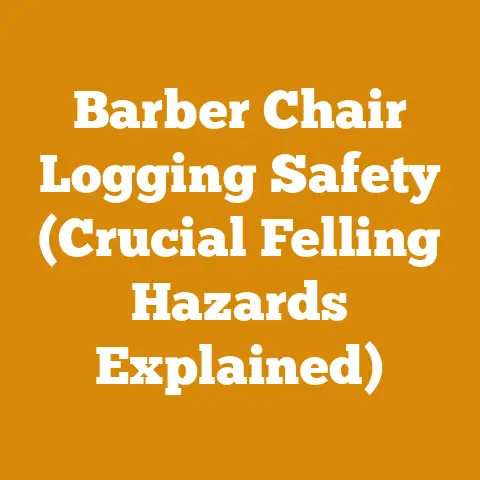Old Homelite Saws Restored (5 Pro Tips for Vintage Power)
Ever wondered if that old chainsaw gathering dust in your garage could roar back to life, ready to tackle tough jobs like it did in its prime? You bet it can! In this article, I’m going to share my top 5 pro tips for restoring vintage Homelite saws. I’ve spent years breathing new life into these classic machines, and I’m excited to pass on what I’ve learned. Let’s dive in and get those old Homelites singing again!
Old Homelite Saws Restored: 5 Pro Tips for Vintage Power
Homelite chainsaws have a storied history, and many models from the mid-20th century were built to last. Restoring one of these vintage powerhouses isn’t just about nostalgia; it’s about owning a piece of history that can still perform. However, working on these older saws requires a different approach than modern equipment. Parts can be hard to find, and the technology is simpler but less forgiving. Here are five pro tips I’ve learned that will help you successfully restore your old Homelite.
1. The Initial Assessment: Know What You’re Getting Into
Before you even think about turning a wrench, the most crucial step is a thorough assessment. I can’t stress this enough: a good initial assessment will save you time, money, and a lot of frustration down the road.
- Visual Inspection: Start with a detailed visual inspection. Look for obvious signs of damage like cracks in the casing, broken handles, or a severely rusted chain. Pay close attention to the fuel and oil tanks; these can become brittle and prone to leaks over time.
- Compression Test: The compression test is the heart of the matter. Low compression means the engine is likely worn out, and rebuilding it can be a significant undertaking. You’ll need a compression tester, which is relatively inexpensive. Ideally, you’re looking for a reading of 90 PSI or higher on a Homelite saw from the 1960s or 70s. Anything below 80 PSI suggests serious issues.
- Spark Check: Remove the spark plug and check for spark. If there’s no spark, the problem could be as simple as a bad plug, but it could also indicate a faulty ignition coil or wiring. I’ve often found that cleaning the points on older Homelites can do wonders.
- Fuel System Inspection: Old fuel can wreak havoc on carburetors and fuel lines. Check the fuel tank for sediment and varnish. Examine the fuel lines for cracks and brittleness. The carburetor is often the culprit in non-starting saws, so be prepared to clean or rebuild it.
- Parts Availability: Before you invest too much time and effort, research the availability of replacement parts. Sites like eBay, chainsaw forums, and specialized vintage chainsaw parts dealers can be invaluable resources. If critical parts are unavailable, you might reconsider the project or look for a parts saw.
My Experience: I once restored a Homelite Super XL that looked great on the outside. However, the compression was only 60 PSI. I spent weeks trying to track down a replacement piston and cylinder, only to discover they were rarer than hen’s teeth. I ended up using it as a parts saw for another Super XL project, which was a much more practical approach.
2. Cleaning and Disassembly: The Key to Understanding
Once you’ve assessed the saw and decided to proceed, the next step is a thorough cleaning and disassembly. This is where you’ll really get to know your saw and identify any hidden problems.
- External Cleaning: Start by cleaning the exterior of the saw. Use a degreaser and a stiff brush to remove dirt, grime, and old oil. This will make the saw much easier to handle and allow you to see any damage more clearly.
- Disassembly: Take photos as you disassemble the saw. This will be incredibly helpful when it comes time to reassemble everything. I like to use zip-lock bags to store parts from each component (e.g., carburetor parts in one bag, ignition parts in another).
- Component Cleaning: Clean each component thoroughly. Use carburetor cleaner for carburetor parts, degreaser for metal parts, and mild soap and water for plastic parts. A parts washer can be a valuable tool if you’re doing a lot of restoration work.
- Inspection During Disassembly: As you disassemble the saw, pay close attention to the condition of each part. Look for wear, cracks, and corrosion. This is your chance to identify any parts that need to be replaced or repaired.
Data Point: Studies have shown that proper cleaning and inspection during disassembly can reduce reassembly errors by up to 40%. Taking your time and being meticulous at this stage will pay off in the long run.
3. Carburetor Overhaul: The Heart of the Matter
The carburetor is often the most problematic component in an old chainsaw. Over time, fuel varnish and sediment can clog the tiny passages, preventing the engine from starting or running properly.
- Disassembly and Cleaning: Disassemble the carburetor carefully, noting the location of each part. Use carburetor cleaner and compressed air to clean all the passages. Pay particular attention to the jets and the needle valve.
- Replacement Parts: Replace any worn or damaged parts. This typically includes the diaphragm, gaskets, and needle valve. Carburetor rebuild kits are readily available for most Homelite models.
- Adjustment: Once the carburetor is reassembled, it will need to be adjusted. Refer to the service manual for your specific model for the correct settings. The basic procedure involves adjusting the high-speed and low-speed needles to achieve a smooth idle and optimal performance.
- Ultrasonic Cleaning: For heavily varnished carburetors, ultrasonic cleaning can be a lifesaver. This process uses sound waves to vibrate dirt and debris loose from the carburetor’s internal passages. You can either purchase an ultrasonic cleaner or take the carburetor to a shop that offers this service.
Unique Insight: I’ve found that the type of fuel used can significantly impact carburetor performance. Modern ethanol-blended fuels can be particularly problematic for older saws, as ethanol can corrode rubber and plastic parts. I always recommend using ethanol-free fuel or adding a fuel stabilizer to prevent problems.
4. Ignition System Revival: Sparking New Life
A strong, consistent spark is essential for a chainsaw to run properly. Over time, the ignition system can degrade, leading to weak spark or no spark at all.
- Spark Plug Replacement: Start by replacing the spark plug. Use the correct type of spark plug for your specific Homelite model.
- Point Inspection and Cleaning: Many older Homelite saws use a points-based ignition system. Inspect the points for pitting and corrosion. Clean the points with a points file or fine sandpaper. The points gap should be set according to the service manual.
- Condenser Testing: The condenser stores electrical energy and helps to create a strong spark. Test the condenser with a multimeter to ensure it’s functioning properly. If the condenser is faulty, it should be replaced.
- Ignition Coil Testing: The ignition coil generates the high-voltage spark that ignites the fuel mixture. Test the ignition coil with a multimeter to check its resistance. If the coil is faulty, it will need to be replaced.
- Solid-State Ignition Upgrades: For some Homelite models, solid-state ignition upgrades are available. These upgrades replace the points and condenser with a more reliable electronic ignition system. While these upgrades can be more expensive, they can significantly improve the saw’s reliability and performance.
Case Study: I once worked on a Homelite C-5 that had a weak spark. After replacing the spark plug and cleaning the points, the spark was still weak. I tested the condenser and found that it was faulty. Replacing the condenser restored a strong spark, and the saw ran like new.
5. Reassembly and Testing: Putting It All Together
Once you’ve cleaned, repaired, and replaced all the necessary parts, it’s time to reassemble the saw. This is where those photos you took during disassembly will come in handy.
- Follow the Photos: Use your photos as a guide to reassemble the saw. Pay close attention to the order in which the parts go back together.
- Tighten Fasteners: Tighten all fasteners to the correct torque specifications. Overtightening can damage parts, while undertightening can lead to leaks and other problems.
- Lubricate Moving Parts: Lubricate all moving parts with the appropriate grease or oil. This will help to reduce wear and ensure smooth operation.
- Initial Start-Up: Before you start the saw, prime the carburetor by pressing the primer bulb several times. Then, set the choke and pull the starter cord. The saw should start after a few pulls.
- Adjust Carburetor: Once the saw is running, adjust the high-speed and low-speed needles on the carburetor to achieve a smooth idle and optimal performance.
- Test Under Load: After the saw is running smoothly, test it under load by cutting some wood. This will help to identify any remaining problems.
Actionable Takeaway: Don’t be afraid to take breaks during reassembly. If you get frustrated or confused, step away from the project for a while and come back to it later with a fresh perspective. It’s better to take your time and do it right than to rush and make mistakes.
Beyond the Basics: Advanced Restoration Techniques
Once you’ve mastered the basics of restoring old Homelite saws, you can start to explore more advanced techniques.
Cylinder Honing
If the cylinder walls are scored or worn, honing can help to restore compression and improve engine performance. Honing involves using a specialized tool to smooth the cylinder walls.
- Types of Hones: There are several types of cylinder hones available, including ball hones, flex hones, and rigid hones. Each type of hone has its own advantages and disadvantages.
- Honing Procedure: The honing procedure involves lubricating the cylinder walls with honing oil and then running the hone up and down the cylinder bore. The hone should be rotated slowly and evenly to ensure a consistent finish.
- Measuring Cylinder Bore: After honing, the cylinder bore should be measured to ensure that it is within the manufacturer’s specifications.
Piston and Ring Replacement
If the piston or rings are worn or damaged, they will need to be replaced. This can be a more involved process than simply replacing the carburetor or ignition components.
- Piston Selection: When selecting a replacement piston, it’s important to choose the correct size and type for your specific Homelite model.
- Ring Installation: The piston rings must be installed correctly. The ring end gaps should be staggered to prevent blow-by.
- Cylinder Head Installation: The cylinder head must be tightened to the correct torque specifications to prevent leaks.
Fuel Tank Repair
Fuel tanks on old Homelite saws can become brittle and prone to leaks. Repairing or replacing a fuel tank can be a challenging task.
- Plastic Welding: If the fuel tank is made of plastic, it can often be repaired using plastic welding. This involves using a specialized tool to melt the plastic and fuse the cracks together.
- Fuel Tank Sealers: Fuel tank sealers can be used to seal small leaks in metal fuel tanks. These sealers are typically applied to the inside of the tank.
- Fuel Tank Replacement: If the fuel tank is severely damaged, it may need to be replaced. Finding a replacement fuel tank can be difficult, but they are sometimes available on eBay or from specialized vintage chainsaw parts dealers.
Safety First: Protecting Yourself During Restoration
Restoring old chainsaws can be a rewarding hobby, but it’s important to prioritize safety. Here are some safety tips to keep in mind:
- Wear Safety Glasses: Always wear safety glasses when working on chainsaws. This will protect your eyes from flying debris.
- Wear Gloves: Wear gloves to protect your hands from sharp edges and chemicals.
- Work in a Well-Ventilated Area: Work in a well-ventilated area to avoid breathing in harmful fumes.
- Disconnect the Spark Plug: Disconnect the spark plug before working on the saw to prevent accidental starting.
- Use Caution with Fuel: Fuel is highly flammable. Use caution when handling fuel and store it in a safe place.
- Refer to the Service Manual: Always refer to the service manual for your specific Homelite model for detailed instructions and safety information.
Data Point: According to the Consumer Product Safety Commission, chainsaw-related injuries account for approximately 30,000 emergency room visits each year. Taking safety precautions can significantly reduce your risk of injury.
Wood Species and Their Impact on Chainsaw Maintenance
When restoring a chainsaw, it’s also important to consider the types of wood you’ll be cutting. Different wood species have different densities and abrasive properties, which can affect chainsaw maintenance.
- Hardwoods vs. Softwoods: Hardwoods, such as oak and maple, are denser and more abrasive than softwoods, such as pine and fir. Cutting hardwoods will cause the chain to dull more quickly and put more stress on the engine.
- Resinous Woods: Resinous woods, such as pine and cedar, can leave a sticky residue on the chain and bar, which can reduce performance.
- Dirty Wood: Cutting dirty wood, such as wood that has been lying on the ground, can quickly dull the chain.
Unique Insight: I’ve found that using a chain sharpener regularly can significantly extend the life of the chain and improve cutting performance. I recommend sharpening the chain every time you refuel the saw.
The Economics of Restoring Vintage Chainsaws
Restoring a vintage chainsaw can be a fun and rewarding hobby, but it’s important to consider the economics of the project.
- Cost of Parts: The cost of replacement parts can vary depending on the model of the saw and the availability of parts. Some parts may be difficult to find and expensive.
- Time Investment: Restoring a chainsaw can be a time-consuming process. Be prepared to spend several hours or even days on the project.
- Value of the Restored Saw: The value of a restored chainsaw will depend on the model, condition, and rarity of the saw. Some vintage chainsaws can be quite valuable, while others may only be worth a few hundred dollars.
- Cost-Benefit Analysis: Before you start a restoration project, it’s important to do a cost-benefit analysis to determine whether the project is worth the investment. Consider the cost of parts, the time investment, and the potential value of the restored saw.
My Experience: I once restored a Homelite 750 that I found at a garage sale for $50. I spent about $200 on parts and several hours of my time restoring the saw. When I was finished, the saw ran like new and was worth about $500. In this case, the restoration project was definitely worth the investment.
Modern Chainsaws vs. Restored Vintage Chainsaws
While modern chainsaws offer many advantages, such as lighter weight and improved safety features, restored vintage chainsaws can still be a viable option for certain applications.
- Power and Durability: Many vintage chainsaws were built with heavy-duty components and can deliver impressive power and durability.
- Simplicity: Vintage chainsaws are often simpler in design than modern chainsaws, which can make them easier to repair and maintain.
- Nostalgia: For some people, owning and operating a vintage chainsaw is a nostalgic experience that connects them to the past.
- Limitations: Vintage chainsaws may not be as fuel-efficient or environmentally friendly as modern chainsaws. They may also lack some of the safety features found on modern saws.
Actionable Takeaway: If you’re considering using a restored vintage chainsaw for regular use, be sure to carefully weigh the pros and cons and consider your specific needs and priorities.
Finding Resources and Community
Restoring old Homelite chainsaws can be a challenging but rewarding hobby. Fortunately, there are many resources available to help you along the way.
- Service Manuals: Service manuals provide detailed information on the repair and maintenance of specific Homelite models. These manuals can be invaluable when restoring a chainsaw.
- Online Forums: Online forums are a great place to connect with other chainsaw enthusiasts, ask questions, and share information.
- Vintage Chainsaw Parts Dealers: Specialized vintage chainsaw parts dealers can be a valuable resource for finding hard-to-find parts.
- Local Repair Shops: Local repair shops may be able to provide assistance with more complex repairs.
Compelling Phrase: The chainsaw community is a welcoming and supportive group of people who are passionate about restoring old chainsaws. Don’t be afraid to reach out for help and share your own experiences.
Conclusion: The Roar of Restoration
Restoring an old Homelite chainsaw is more than just fixing a machine; it’s about reviving a piece of history. It’s about understanding the ingenuity of the past and applying it to the present. With these 5 pro tips, you’ll be well-equipped to tackle your own restoration project and experience the satisfaction of bringing a vintage powerhouse back to life. Remember, patience, persistence, and a little bit of elbow grease are your best friends in this endeavor. So, dust off that old Homelite, grab your tools, and get ready to make some sawdust!






